President's Message
The Sandston Founders Club commemorated its 10th anniversary at their annual meeting held on April 26 at the Sandston Recreation Center. It was my pleasure to attend and meet members who grew up in Sandston (as the name of the club implies).
The community was founded in 1921 at the end of World War I. Today longtime residents include second and third generation families.
HCHS Vice President, Alice Baldwin, serves as president of the club.
Just ask a busy person to participate in a project and they are always available, which brings to mind the following:
I actually found this wordplay in my yard and have no idea from whence it came. It had obviously been out in the weather a while. No doubt someone considered it worth keeping, but somehow it got away, or perhaps it just fell from the sky to share with all of you.
TATER PEOPLE
Some people never seem motivated to participate but are just content to watch while others do the work. They are called Speck Taters.
Some people never do anything to help but are gifted at finding fault with the way others do the work. They are called Comment Taters.
Some people are very bossy and lie to tell others what to do but don’t want to soil their own hands. They are called Dick Taters.
Some people are always looking to cause problems. It is too hot or too cold, too sour or too sweet. They are called Agie Taters.
There are those who say they will help but just never get around to actually doing the promised help. They are called Hezzi Taters.
Some people can put up a front and pretend to be someone they are not. They are called Emma Taters.
Then there are those who love others and are always prepared to stop and lend a helping hand. They bring real sunshine into the lives of others. They are called . . . Sweet Taters.
(Author unknown)
I would like to take this opportunity to thank all of the Sweet Taters who volunteer their time and lend helping hands on behalf of the Henrico County Historical Society.
Sarah Pace
President
>Back to Top<
All About Elko
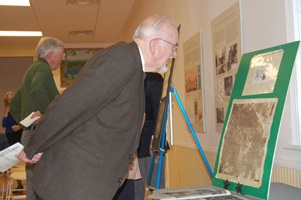
Left: Dr. Louis Manarin peruses one of the many exhibits Sandy Fischer supplied related to the history of the Elko area.
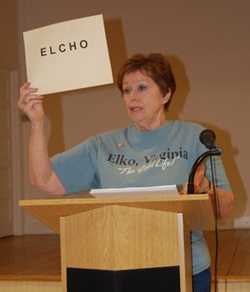
Left: Sandy Fischer speaks to the Henrico County Historical Society at its March 2014 meeting. She spoke on the history of the Danish and Norwegian settlement in the area and the Windsor Club. In the photograph, she holds up a sign indicating a possible source for the community's name.
>Back to Top<
Voting on Directors Positions
Terms have expired for Directors of the Three Chopt and Varina Districts, and elections will be held at the June meeting.
>Back to Top<
10th Anniversary Celebration
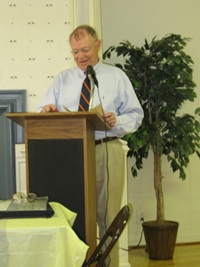

Above: Sandston Founders Club President Alice Baldwin addresses the members at the April 26 tenth anniversary meeting.
Above left: Dr. Reeves Bailey speaks about his father, Dr. Herman Bailey, who had treated and even delivered many of the club members.

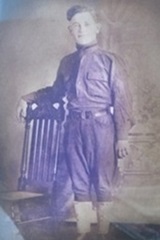
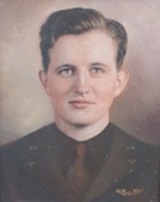
Left: Ada M. Kahn Chinn share memorabilia related to her family members who had served in World War I (middle) and World War II (right).
>Back to Top<
APHA Collaborative Restoration Project Goes Partially 'Underground'
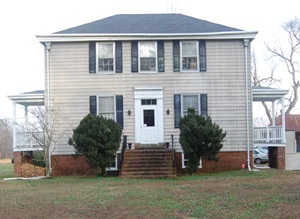
In its continuing mission to help rescue, preserve and protect sites of historic interest in Henrico County, the Association for the Preservation of Henrico Antiquities has partnered with the owner of Farmer’s Rest, a circa 1839 two-story structure in the county's East End. The photograph above shows the house before work was begun to replace the siding.
An interesting feature of the house is the floor plan which features a hallway extending across the front of the house, a floor plan mirrored in the basement. This can be seen by comparing photo 2 and 3. It is in the basement that the bulk of restoration and reclamation has taken place.
Photo 1 shows the stairway and hall in the basement before work was begun. Photo 2 shows the same area after recently completed work including pouring a new floor, replastering walls and restoring the stairway.
Photos 4 shows a view of the basement before work was begun, while photos 5 and 6 show two basement rooms in their restored state.
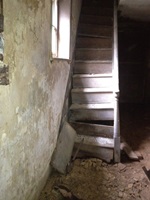

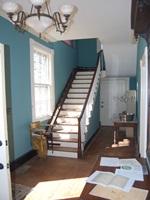



>Back to Top<
In the 1860s, James River Brewery Could Roll Out the Barrels of Brews Down by the River
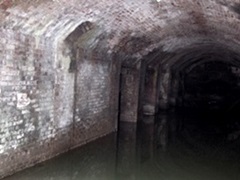
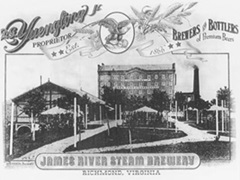
Nineteenth Century cooler: The image on the left is one of the James River Steam Brewery tunnels opening onto the James River stands idle and is filled with water that has seeped in. The image on the right is an ad for David Yuengling's beer.
Rocketts Landing on the James River right at the Richmond/Henrico line has undergone a number of transitions. The area's development began with a ferry service operated by Robert Rocketts in 1730, for transporting goods. Through the nineteenth century it housed a number of industrial enterprises like the Richmond Cedar Works, whose building still stands with its identifying sign repainted on the building after its conversion to condominiums. Besides upscale condominiums, the 20-block mixed use Village at Rocketts Landing has become the site of swimming facilities, walking trails, restaurants and boat docks. But there is also a crumbling remnant of its industrial past waiting to be brought back–the site, or at least what is left of the site, of the James River Steam Brewery.
In 1866, David Yuengling, Jr., son of the founder of "America's Oldest Brewery," established the brewery at 912 East Main Street near what was then Wharf Street. Its location seemed well suited for the enterprise because river boats could tie up at the brewery's dock and trains could stop along the railroad to load the beer from the vaulted tunnels that served to keep the brew cool in the days before refrigeration.
The operation seemed to be rather successful, and in 1867, the Richmond Whig indicated that it produced 400 barrels (12,400 gallons) per day. And many enjoyed their share of the 400 barrels, as Alexandria's Daily State Journal of September 15, 1873, reported: "Alois Rick, the well known pavier, has returned from the Vienna exposition and resumed operations in the line of his profession. He says the Vienna beer is not as good as Yuengling's Richmond article." However, Yuengling found the endeavor disappointing and sold the operation to the Richmond Cedar Works in 1878.
According to the April 3, 1883, Staunton Spectator, Yuengling complained, "We make the best beer in the world in the United States. . . After the war I went to Richmond, Va., and put $500,000 in a brewery, and came back without a dollar, and by hard labor have made another in New York - the farmers of Virginia forced their taxes upon the manufacturer, making me pay eighty-five cents a barrel on my beer and admitting distant bring beer from New York and Baltimore at less than they would carry it twenty miles out of Richmond for me. The brewery is there yet, idle, and no brewer has been successful in the south. They won't drink beer."
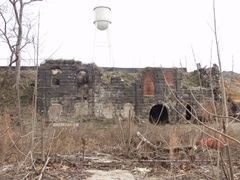
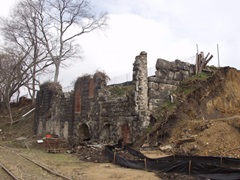
A fire destroyed the building in 1891, and the cellars have stood vacant since then. There are four vaulted tunnels - the largest of which is ten to seventeen feet wide and 146 feet long - and water seeps into them flooding the floor. The state's Department of Historic Resources board voted to add the remnants of the brewery to the Virginia Landmarks Register and nominate it to the federal list to protect historic and archaeological resources. Possible plans for the cellars involve the developer's hope to convert them to a restaurant - a use that almost brings the tunnels' lives full circle.

The ad shows the layout and location of David Yuengling, Jr's James River Steam Brewery.
>Back to Top<
Redo's Redux
Commercial: In 1892, Peter Stumpf opened the Richmond Brewing Company, and he eponymously renamed it Peter Stumpf Brewing Company the following year. His beer was bottled in heavy blob top bottles as seen directly above, and the bottles were sealed with a metal bail that held a cap and gasket in place. His initials (PS) appear on the end of the barrel held by the eagle. It is one of several iterations of this collectible beer bottle.
Stumpf retired in 1897, and the company became Home Brewing Company, a company that was active in Richmond for many years. Not only did the brewery change hands, but all its inventory also passed into the hands of the new owners.
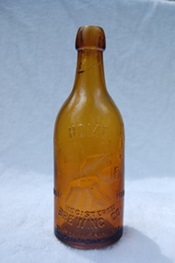
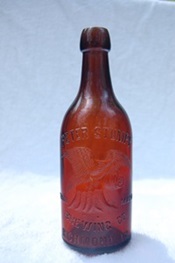
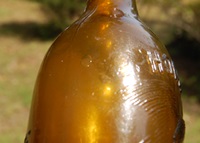
Included in that inventory were the molds used to cast the bottles, and Home Brewing adapted those molds to its own purpose. That reuse (or redo for our purposes) is demonstrated by the bottle directly above. The shoulder of the bottle beside the word Home has some rough sections, and if one looks closely, the vague remnants of Peter Stumpf can be seen (the detail at the top shows this). Apparently, the bottles were valuable enough that the new company took the old molds, removed the original name and altered the mold to say Home, leaving faint vestiges of the original name on the new bottles.
Domestic: In the home, prized items were often repaired, as the March article about redo's showed. During Victorian times, perfume bottles like the one seen at the top of the page were valued. This bottle, supplied by Martha Patterson of Antique Boutique in Richmond, had its top broken off at some point, and the distraught owner had it repaired. The dark area in the larger photograph is a small metal rod inserted into holes drilled for it, restoring the top of the stopper to its original position, though not its original condition.
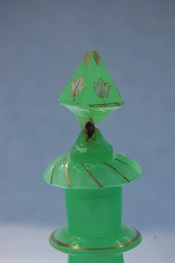

>Back to Top<
Now You Know
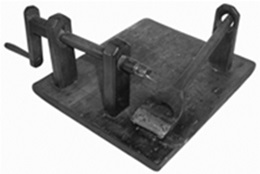
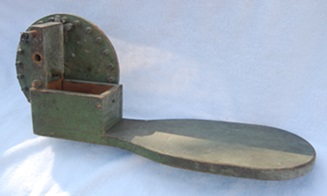
Early Apple Peelers
The item above was featured in our March "What Do You Know?" It is a very early apple peeler. Apples were speared on the prongs protruding from the small rod at the top. Someone sat on the flat seat and turned the cogged wheel while holding a blade against the fruit to remove its peel. It is appropriately painted apple green. Other photographs depict other types of apple peelers used in the eighteenth and nineteenth centuries. Food and its preparation gives us insight into a culture, and Mary Randolph's The Virginia Housewife Or, Methodical Cook can tell us a good deal about early nineteenth century Virginia culture. We offer several of her apple recipes for your experimentation.
Compote of Apples
Pare some apples and cut them in thin slices, put them in a bowl, with a glass of brandy, some white wine, and quarter of a pound of powdered sugar, a little cinnamon finely powdered and the rind of a lemon grated: let them stand some time, turning them over frequently; beat two eggs very light, add one quarter a pound of flour, a tablespoonful of melted butter, and as much cold water as will make a thin batter; drip the apples on a sieve, mix them with the batter, take one slice with a spoonful of butter to each fritter, fry them quick, of a light brown, drain them well, put them in a dish, sprinkling sugar over each, and glaze them nicely.
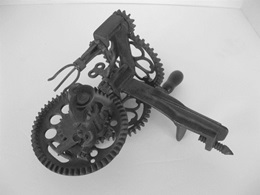
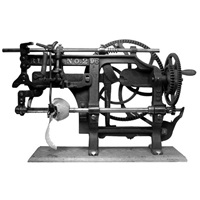
Apple Fritters
Beat six eggs very light, add a pint of rich milk, pare some apples or peaches - slice them thin, make the eggs and milk into a tolerably thick batter with flour, add a small cup of melted butter, put in the fruit, and bake it in a deep dish - eat with sugar, butter, and nutmeg.
>Back to Top<
What Do You Know?

The item pictured at the left is 6" long and 3/4" wide. It is made of either bone or ivory with silver filigree.
Do you know what it is?
Email your answers to: jboehling@verizon.net.
>Back to Top<
News 2014: Second Quarter
First Quarter | Third Quarter | Fourth Quarter
Home | Henrico | Maps | Genealogy | Preservation | Membership | Shopping | HCHS
|











